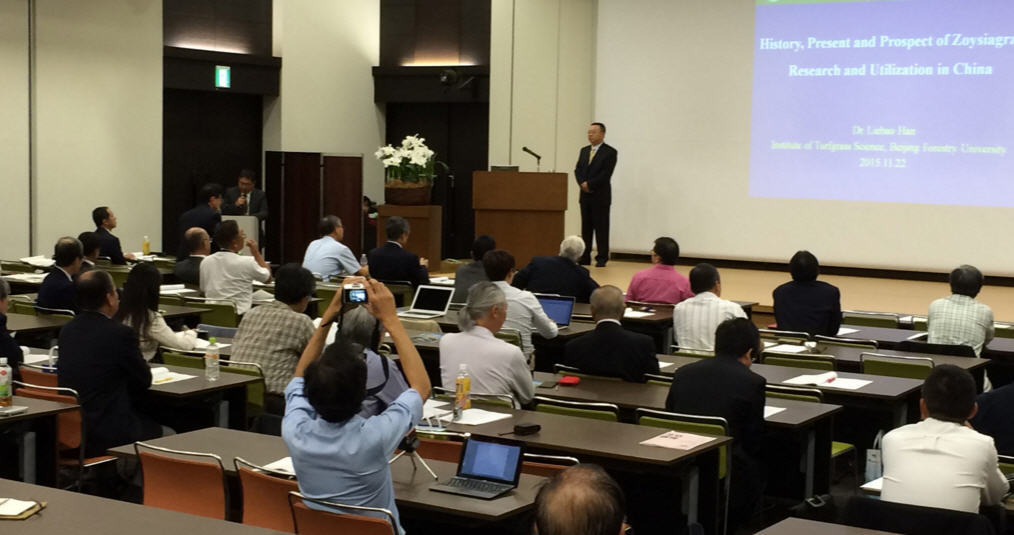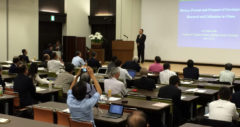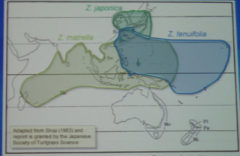
Zoysia species of grasses have been in cultural use for sports well over a century, but they have been cultivated in Asia for aesthetic uses for millennia, writes James Graham Prusa.
Well attended by approximately 150 people, the 2015 International Zoysiagrass Symposium this last November 2015 was sponsored by the Japanese Society of Turfgrass Science. It was a resounding success all around. Individual attendees were drawn from East Asia nations representing universities, facility management practitioners, and various commercial companies made this the first conference of its kind to draw a concentrated focus on the history, research, breeding and usage of Zoysia throughout East Asia and Australia / New Zealand.
The speakers were world-class Zoysia aficionados and each of them was from this part of the world (AustroAsia) – this was unique in itself in that the usual occidental turfgrass ‘experts’ were completely absent. Quite frankly, the professors from China, Japan, Korea and Australia revealed for the first time that an abundance of Zoysia research efforts and breeding programs have been ongoing here in Asia for a number of years and interest in Zoysia is strong. Each speaker provided an historical review on Zoysia development efforts in their respective nations as well as their currently ongoing efforts to breed improved varieties of grasses for commercial use.

Dr. Choi Joon-Soo, Dean, College of Plant Resource Science, Dankook University, congratulated the organizers of the event and made an impassioned appeal for continued collaboration and communication amongst those present to further advance progress and use of Zoysia in East Asia. Dr. Choi’s presented a considerable amount of information on Zoysia usage in Korea and his ongoing research efforts.
Next Professor Liebao Han, Ph.D., from the Institute of Turfgrass Science, Beijing Forestry University presented an extensive review of ongoing efforts in China to further advance new Zoysia varieties for commercial use including tissue culture applications to develop new, transgenic plants of Z. japonica. His efforts have gained substantial support and a keen interest by the Chinese government
Another well recognized Zoysia development pioneer in attendance was Dr. Donald Loch from Australia, who in retirement now serves as an Honorary Senior Fellow in Turfgrass Management at the University of Queensland. He presented an excellent review on the complex taxonomy of Zoysia as well as invaluable information on its distribution, popularity and management factors.
Makoto Kobayashi, Senior Researcher for the National Agricultural and Food research organization of Japan provided an in depth assessment on the importance of Zoysia grass in Japanese society. Dr. Kobayashi also explained correlation of Zoysia species distribution based upon rainfall and temperature factors. This presentation covered the distributive commercial use of Zoysia, its sod production, current information about commercial varieties in use, and IPR varietal rights definitions in Japan. He also noted how Zoysia was used in the post-disaster recovery from the Fukashima earthquake and tsunami – and that this points a future social value for society in renovating school grounds and sports fields.
Additional speakers made presentations including Toshiro Hayakawa of Rikengreen on diseases of Zoysia; Okazaki Maiko of Utsunomiya University on inflorescence and regeneration; and Hidenori Tanaka of Miyazaki University on genetic diversity and morphological traits of Zoysia species. The latter information provided in Dr. Tanaka’s presentation was of much interest in that it used gene mapping to show how Z. matrella clearly shares abundant DNA microsatellite markers of both Z. japonica and Z. pacifica.
During ensuing open discussions, concerns were expressed for what ‘next-steps’ should be taken in Zoysia research and development by both the attendees and speakers. A portion of this open discussion was spent on how to deal with the challenges of organizing these grasses taxonomically as dependence on morphological factors alone is no longer the sole answer in light of advances in genetics (just as takes place in all areas of plant and animal classification today).
The conference was, hands-down, an excellent effort that has now placed greater emphasis and momentum on the development of improved Zoysia grass varieties in Asia, for Asia and by Asians. This Japan event set the stage for near term cooperation amongst the Asia researchers that, if followed through on, could see the rapid rise of interest and commercial support for developing more new Zoysia grasses for the region. Of course, breakthrough developments of Zoysia varieties here in Asia also will spur interest in other parts of the world for use of such grasses.
Just as some speakers this year suggested that more communication and collaboration be focused on Zoysia, it would be wise to make this an annual event and rotate venues. Additionally, now that the core leadership of Asians has a firm handle on the Symposium, it would also be synergistically valuable to invite foreign occidental Zoysia scientists for presenting at subsequent events. There has been much R&D investment in the West toward improving Zoysia and a world gathering of all of the involved scientists and investors would be best held here in Asia.
In recognizing the challenges with the multitude of languages in East Asia, and to ease communications for the symposium, the organizers set a protocol for all speakers to present using English — and this proved very beneficial. However, while it would be wise to continue the official use of English for presenting, this writer would suggest that modern technology of laptops and visual projectors could be employed to at least communicate and project simple text summaries of speakers’ key points in Chinese, Japanese and Korea for all attendees who may not be strong in English – especially for the management practitioners who attend. Having spent over a decade in Asia, I have found that ‘oral translation’ is not really required in order to have good communication (especially the expensive and tiring simultaneous interpretation is not needed), but rather just having one or two people typing simple notes that others can see suffices to easily follow key points, graphics and photos during a presentation. Such clarification of the non-verbal communication can readily be done using personal laptops in messaging applications that would even allow two-way communication with a translator and a language group of attendees (texting the context of a speaker engages people for better assimilation and attention too). After all, most of communication in A/V presentations is non-verbal anyway – especially in technical realms.
All-and-all this was a very beneficial conference that bodes well for further developing the requisite industry awareness and knowledge of Zoysia grasses here in Asia. Zoysia is the indigenous, viable answer for the economic and aesthetic sustainability of turfgrass cultivation in Asia, albeit for golf, sports, schools or forage. Our successful survival in sports turf depends on the rapid development of improved Zoysia. The golf course and sports facility industries in Asia must engage and support Zoysia R&D. The Japanese Society of Turfgrass Science and others need to be congratulated and thanked for their efforts that will surely benefit all of the turfgrass industry in Asia and beyond. Let’s hope the organizers immediately follow through and set careful dates for a second symposium in 2016 for Asia.




